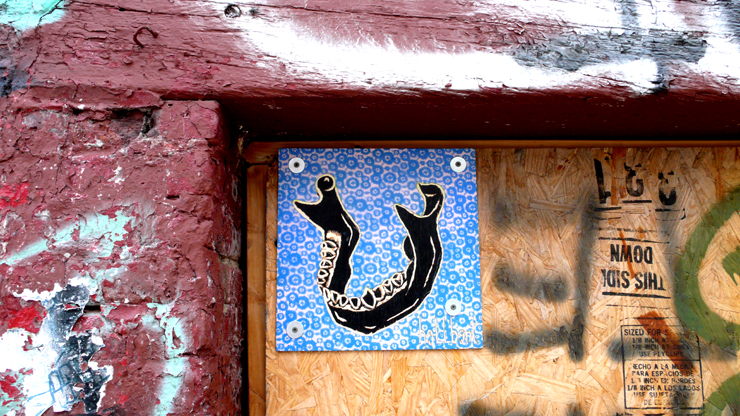The streets are covered with symbols and markings that have meaning to the maker, their peers, and to passersby. Depending on socio-political-geo-historical factors, you may or may not know what certain tags or images are meant to indicate and aside from gang indicia, no one seems particularly alarmed by this fact that street art and graffiti is often a nest of hidden meanings.
Hellbent (Photo © Jaime Rojo)
One such symbol that has often appeared on the street is the bottom jaw from Hellbent, rough and jagged, hovering above a bed of psychedelic or pastel floral patterns. If it happened once, you might think “Oh, it’s part of a series and I’ll figure it out when I see the other pieces”. In fact, no. It’s the one symbol that Hellbent repeats most often, and it is perplexing.
Hellbent (Photo © Jaime Rojo)
We finally got an answer from the artist regarding the genesis of the jaw when he was describing his current piece in the LA show “Street Art Saved My Life” and, while it sheds light on the background, somehow it raises more questions. In the story about this Austrian neurologist who founded the discipline of psychoanalysis, we postulate that the jaw represents our base animal qualities and our similarities to the ruthless animal kingdom, all the while acknowledging the ultimate fragility of a simple bone structure, and be extraction, us. Anyway, before we psychoanalyze it further and bore everybody in the room, here’s what Hellbent says:
“Sigmund Freud at age of 67 appeared in a clinic in Vienna because he had discovered some hard, smooth spots on his jaw. After the doctor examined him it was discovered that they were cancerous and the lesions had to be removed immediately. Since the hospital population at that time was at capacity, Freud was put in a makeshift room that he shared with dwarf. After his operation while his family was out, Freud began to hemorrhage and was unable to call out, while laying bleeding on the floor. If not for the dwarf roommate Freud would have surely died and with this I began thinking of the jawbone. BROOKLYN STREET ART LOVES YOU MORE EVERY DAY
BROOKLYN STREET ART LOVES YOU MORE EVERY DAY











